
VIDEO - The Court of Burgundy - Music and Rogier van der Weijden
The Burgundian Netherlands refers to an area encompassing the Low Countries (Belgium, the Netherlands, Luxembourg) and northern France during the period when it was ruled by the dukes of Burgundy, from the end of the fourteenth to the end of the fifteenth century. Most of these territories came into the possession of the Burgundian dukes—who were descended from the French royal house of Valois—in 1384, with the death of Louis de Mâle, count of Flanders. Louis’ son-in-law Philip the Bold (1342–1404), first Valois duke of Burgundy, thus inherited the counties of Flanders, Artois, Rethel, Burgundy, and Nevers (through his wife, Margaret of Flanders), initiating an era of Burgundian governance that would last until 1477, when the duchy of Burgundy reverted to France, and the Netherlands passed to the Habsburg dynasty.
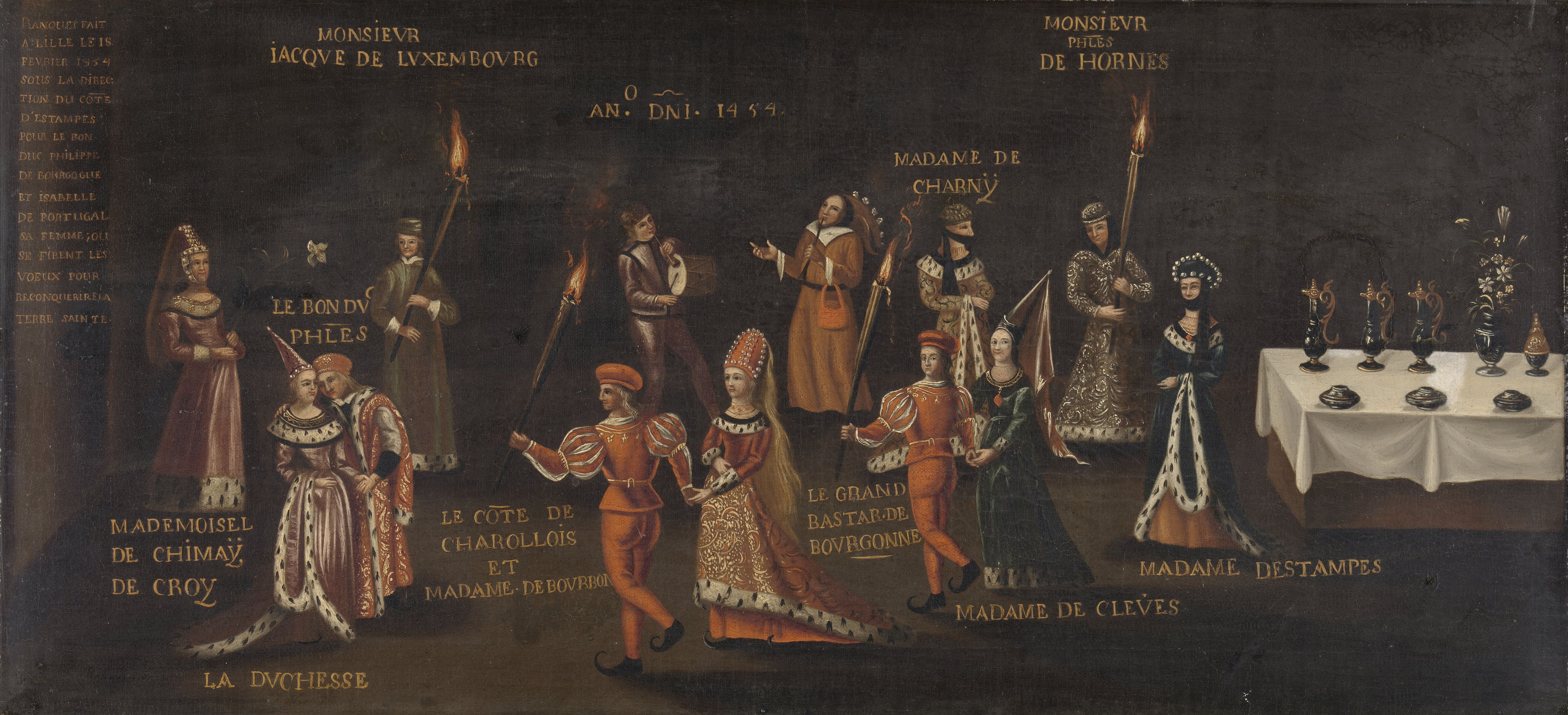
The Feast of the Pheasant (Banquet du Vœu du faisan, "Banquet of the Oath of the Pheasant") was a banquet given by Philip the Good, Duke of Burgundy on 17 February 1454 in Lille, now in France. Its purpose was to promote a crusade against the Turks, who had taken Constantinople the year before. The crusade never took place.
Seignor, sachiez, qui or ne s’an ira
en cele terre ou Diex fu mors et vis
et qui la croiz d’outremer ne penra
a painnes mais ira en paradis.
Qui a en soi pitié ne remembrance,
au Haut Seignor doit querre sa vanjance
et delivrer sa terre et son paï
Français moderne:
Seigneurs sachez: qui point de s’en ira
En cette terre où Dieu fut mort et vif,
Et qui la croix d’outremer ne prendra,
A dure peine ira en paradis.
Qui n’a en soi pitié ni souvenance,
Au haut Seigneur doit chercher
cher sa vengeance,
Et délivrer sa terre et son pays.
Lords, know this: whoever will not now go to that land where God died and rose again, and whoever will not take the cross to Outremer will find it hard ever to go to heaven. Whoever has pity and good remembrance in his heart must seek to avenge the Highest Lord and liberate His land and His country.
Medieval Dance Music La Rotta - Feast of the Pheasant
Stundenbuch der Maria von Burgundy Wien cod. 1857 14v 15r
Mary of Burgundy can be identified as the woman in the foreground of folio 14v from the facial similarity to documented contemporary drawings and paintings. She is shown as an elegant young princess, reading a book of hours. Her finger traces the text of what seem to be the words Obsecro te Domina sancta maria ("I Beseech Thee, Holy Mary"), a popular prayer of indulgence in contemporary manuscript illuminations of donors venerating the Virgin and Child. Mary is positioned in an intimate and private domestic setting, probably a private chapel or oratory, reading a book of hours draped in a green cloth. A small white dog, a symbol of faithfulness, rests on her lap. She wears a gold or brown velvet dress, and a long hennin, from which hangs a transparent veil. The window before her is opened through two timber boards adorned with glass. Its ledge contains a veil, rosary beads, a gold chain with ruby and four pearls, two red carnations as symbols of betrothal, and a crystal vase containing a large flowering iris, a late medieval symbol of purity.
The Virgin and Child are visible through the open window as an "image within an image", as if as an apparition or the literal embodiment of the book she is reading. Thus Mary of Burgundy is placed in physical proximity to the Virgin, without the usual intercession of the saint. The holy family are seated in a Gothic church with a high vaulted ambulatory, before the high altar, in front of which is a lattice-patterned decorative carpet. Four angels sit at the corners of the carpet, each holding a gold candlestick marking the sacred space. Three court ladies, one looking outwards, are positioned to the left, kneeling with their hands clasped in prayer. One, probably Mary of Burgundy, wears a blue brocade and gown and holds a small book in her hands. The other two ladies seem to be her attendants. A male figure kneeling to the right is dressed in red and swings a censer of burning incense, while two other figures are positioned behind the high altar.
Kyrie
Rogier van der Weyden- The Middelburg Altar ca 1450
The central panel shows the birth of Christ with the donor worshipping the child, who is lying on the floor of the stable, with a bright light around him. The Romanesque architectural forms of the building make it clear that the appearance of Christ brought a new era. Joseph is protecting the candle-flame to show that all earthly light is outshone by the divine child. On the right-hand panel the Three Magi are kneeling before the divine child. The left-hand panel shows Emperor Augustus, the ruler of the Western world, accompanied by a prophetess, kneeling to the vision of the Madonna. The triptych thus encompasses the whole world in that the rulers of the East and the West submit to the infant Christ, the King of Kings.

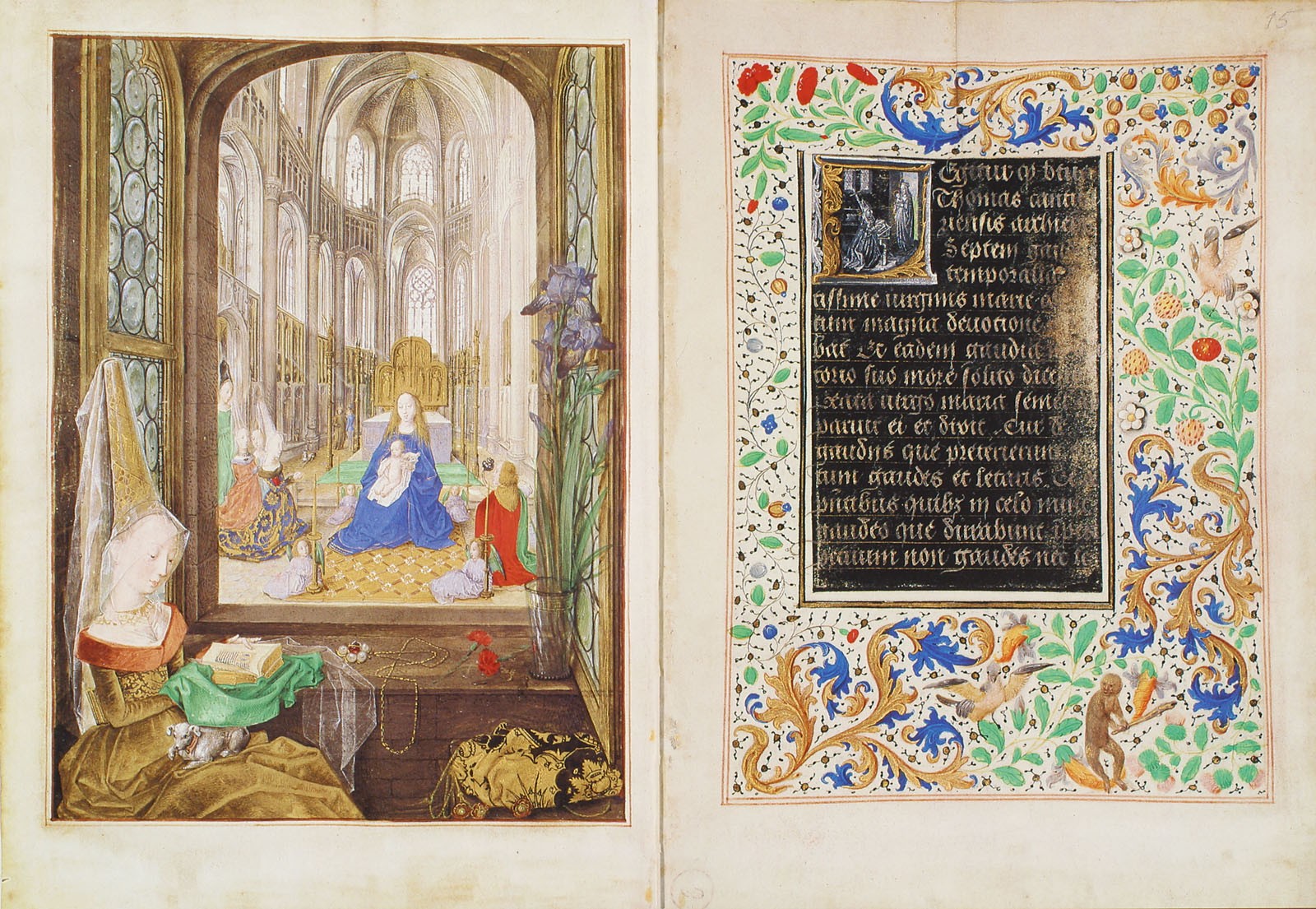
Stundenbuch der Maria von Burgundy Wien cod. 1857 14v 15r
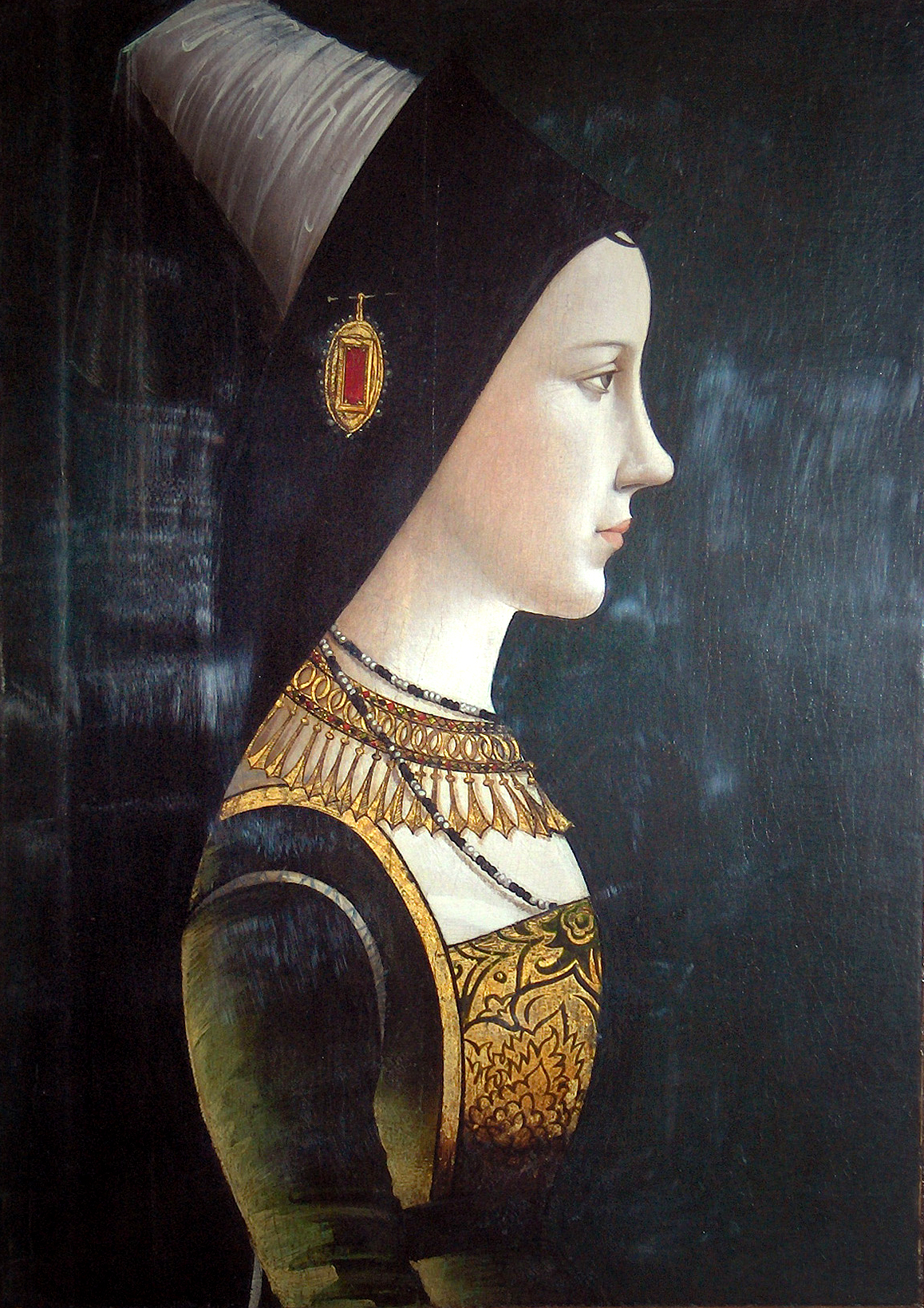
MARY OF BURGUNDY VIDEO
Mary of Burgundy
Mary was born in 1457, the only child (by all accounts legitimate and illegitimate) of Duke Charles the Bold of Burgundy and his second wife, Isabella of Bourbon. Isabella died when Mary was just eight, however, and Charles soon re-married, which meant that the young Mary grew up primarily with her stepmother, Charles’ third wife, Margaret of York, the sister of King Edward IV of England. The two were reportedly very close, with Margaret providing advice and guidance to her stepdaughter, who carried a great weight of expectation on her shoulders.
As the daughter of Charles the Bold, Mary was the heir to one of the richest and most powerful territories in fifteenth-century Europe (she was sometimes known as ‘Mary the Rich’). This, naturally, also made her one of the most desirable marriage prospects. But before any marriage plans could be officially declared, Charles was killed at the Battle of Nancy in 1477, when Mary was only twenty. Mary now faced pressure to marry as quickly as possible. Although she had several suitors vying for her hand, including the dauphin of France, Charles, son of Louis XI, she eventually settled on the eighteen-year-old Archduke Maximilian of Austria, future Holy Roman Emperor.
Remarkably, Mary and Maximilian’s marriage seems to have been one of those rare medieval royal matches that grew into true affection. The young couple shared many interests, including a love of animals, hunting, falconry, horseback riding, and the outdoors and other physical pursuits. Maximilian was fascinated by the Burgundian court culture, with its legacy of grand tournaments, and his time spent in Mary’s court following their marriage appears to have been one of the happiest times of his life.
Juan Luis Vives, a Valencian scholar and author of the sixteenth-century manual The Education of a Christian Woman, used Mary and Maximilian as a positive example of marriage. In it, he wrote:
‘Mary the wyfe of Maximilian the emperour / whiche had by her father of inheritance all Flanders and Pycatdye / and the people set nought by the symple and softe disposition of Maximilian / and sewed for all theyr matters vnto Mary his wyfe / yet wolde she neuer determyne nothyng without her husbandes aduise / whose will she rekened euer for a lawe / though she myght well inough haue ruled and ordened all as she lyst / with his good wyll: whiche vsed to suffer of his mylde stomacke any thing yet she lyst / vnto his good and prudent wyfe / & that in her owne goodes. So Mary by obeynge her husbande / and regardyng hym so well / brought hym in to great auctorite / and made the people more obedient vnto them both / as though their powers were increased and ayded either by other.’
Vives portrays Mary as a good wife due to her deference in all things to her husband. Yet he also reveals that the Burgundian people were not keen on the young archduke; they preferred to turn to Mary, their rightful ruler, with their troubles. It was only through Mary publicly recognising Maximilian’s authority that he achieved some level of respect.
Mary and Maximilian had two children who survived to adulthood: Philip ‘the Fair’ (1478-1506), future Duke of Burgundy and father of Holy Roman Emperor Charles V, and Margaret (1480-1530), whom we will encounter again in a few weeks. Yet sadly Mary and Maximilian’s marriage was short-lived. In 1482, while out hunting with her husband, Mary was thrown from her horse. She died several weeks later from her injuries; she was only twenty-five. It is also possible that she was pregnant when she died.
Maximilian was, by all accounts, broken-hearted by Mary’s tragic death.


Ten weepers from the tomb of Isabella of Bourbon, Borman workshop (attributed to), Renier van Thienen (I) (attributed to), c. 1475 - c. 1476
Commissioned by Mary of Burgundy (1457-1482), Brussels, as part of the tomb of her mother, Isabella of Bourbon (1436-1465), 1475; installed in the Sint-Michielsabdij, Antwerp, 1476; ? dismantled during the iconoclast uprising, August 1566;...; collection Jan de Vos, Amsterdam, before or in 1691; his son Pieter de Vos, Amsterdam, March 1691; from whom acquired by the City of Amsterdam, and installed in the ‘Thesaurie Ordinaris’ of the Town Hall (at Dam Square), Amsterdam, 1691; transferred to the Cabinet of Curiosities in the same building, April 1806; transferred to the Cabinet of Curiosities in the Town Hall (Prinsenhof), Amsterdam, 1808; transferred to the ‘Historische Tentoonstelling’ in the Oude Mannenhuis, Amsterdam, 1876; transferred to the Amsterdams Museum in the same building.
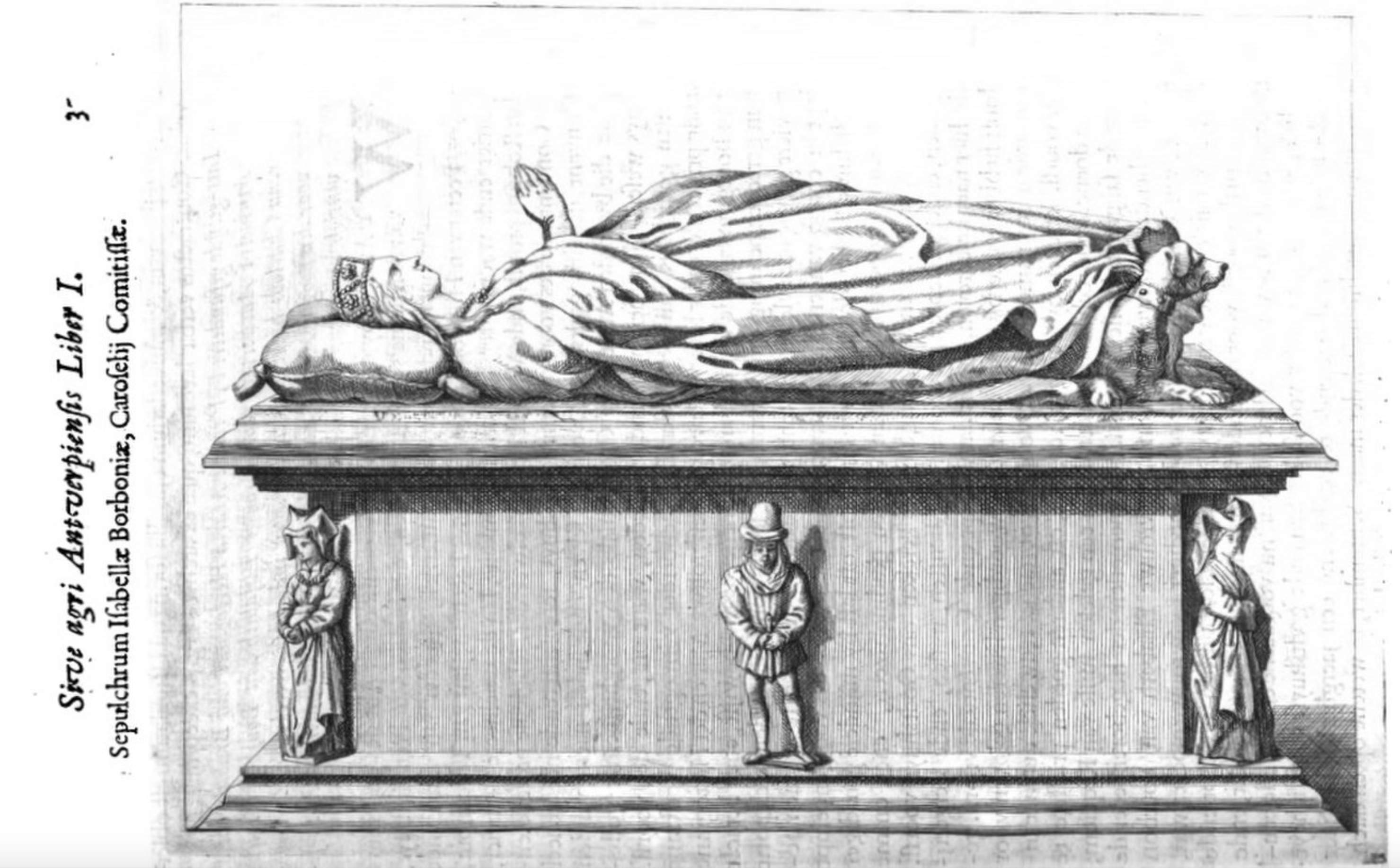
TOMB
Isabella's early death meant that she had little significance or influence during her lifetime, but in her death she became a symbol of the wealth of the Dukes of Burgundy, which would later be inherited by her only daughter Mary. As the duke's second marriage failed to produce any sons, Mary was heiress to the duchy, and her marriage to a Habsburg had major repercussions for centuries.
Isabella's funeral monument was erected in the church of St. Michael's Abbey, Antwerp in 1476. It was decorated with 24 bronze statuettes of noblemen and women standing in niches, known as 'weepers' or 'mourners', with a bronze effigy of Isabella herself surmounted on it. During the Iconoclast Fury of 1566, radical Protestants destroyed images in Catholic churches and monasteries. The destruction was justified by Calvin's contention that all images in churches were idolatrous and had to be removed. As a result, Isabella's tomb was stripped of its decorations and the 'mourners' disappeared.
However, ten of them turned up in Amsterdam. In 1691 the burgomasters of Amsterdam purchased the ten statues which they thought represented the counts and countesses of Holland. Pieter de Vos, 'clerk of the secretariat', was the man who sold the statuettes, which he had presumably inherited from his father. In exchange for the statues De Vos received an annual pension of 150 guilders. He died in 1721; the city had therefore paid De Vos around four thousand five hundred guilders for the mourners.
The clothes worn by the mourners are of an earlier fashion than Isabella's. This is probably because the mourners were copied from older tombs, which are no longer in extant. The statuettes are copies from two earlier tombs, which were the work of the sculptor Delemer, the painter Rogier van der Weyden and the bronze-founder Jacob de Gerines, commissioned by Philip the Good. It is assumed that the models for the Amsterdam statuettes were supplied by Delemer or his workshop.
In fact the mourners are not Isabella's immediate family: they represent her ancestors. Two portraits have been identified as Emperor Louis of Bavaria (with the imperial crown and orb) and Albrecht of Bavaria, with the St Antony cross around his neck. These portraits have been identified on the basis of a list of names published in 1695 by Daniel Papebrochius. The statuettes reveal the kind of clothes worn by Burgundian nobles in the Late Middle Ages. An unusual aspect is the amount of cloth employed in the garments: the sleeves are exceptionally long, as are the robes. Various kinds of headgear are worn, both by men and women, the latter of whom have shaven heads, as was the fashion in those days.
These statues have been on display in the Rijksmuseum for around a hundred years. The rest of the tomb, with the statue of Isabella, is now in Antwerp cathedral. Nothing more of the tomb furnishings survives.



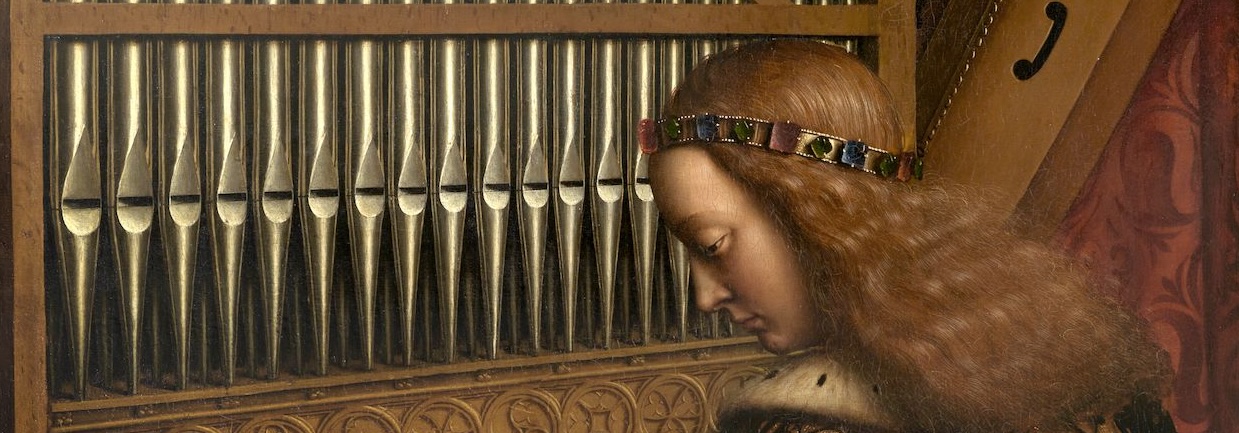
JAN ALAERTS, kapelaan bij het altaar van Johannes-de-Doper in de Sint-Janskerk te Gent 1454
 Foundation Musick's Monument
Foundation Musick's Monument